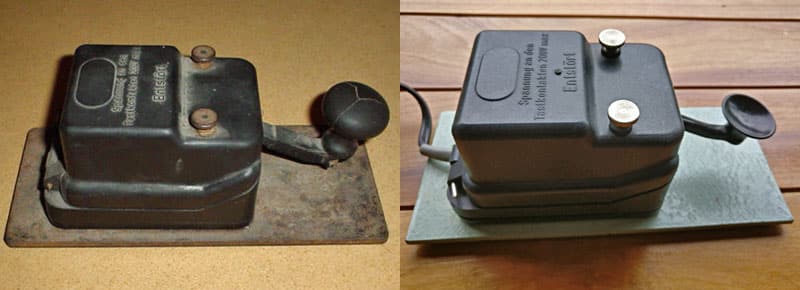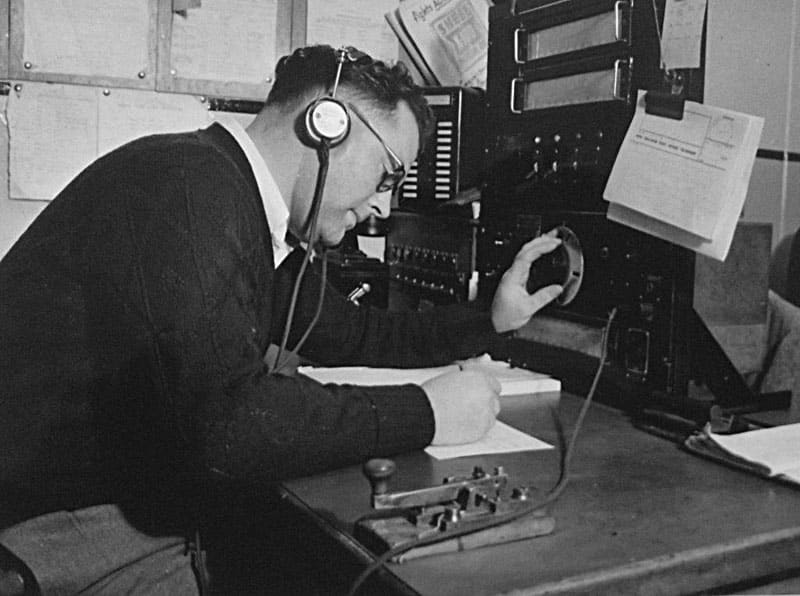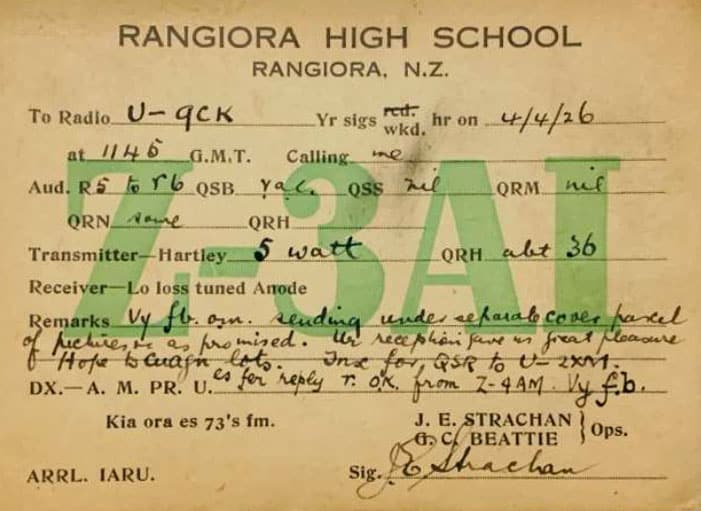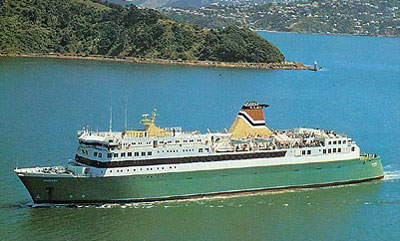This is a fortnightly newsletter about the New Zealand Net. If you would like to be notified by email when a new edition is published, please contact ZL1NZ.
Browse our newsletter archive.
Featured key

Entstört keys. Photos: David Smith ZL2WT
Here’s a pair of East German Entstört keys with some fascinating history.
The one on the left was recovered from the wreck of Mikhail Lermontov, the Soviet cruise ship that was driven onto rocks by the Marlborough harbour pilot in 1986, killing one crew member. The ship sank a few hours later in Port Gore.
David Smith ZL2WT picks up the story:
 In 2002, I visited a radio amateur who lived on the hill behind the Wellington Inter-Island ferry terminal. His name is Tony Brown and he had been given one of the keys from the Lermontov by someone who had retrieved it when diving on the wreck. The Entstört key is of East German manufacture, and Mikhail Lermontov was built in East Germany.
In 2002, I visited a radio amateur who lived on the hill behind the Wellington Inter-Island ferry terminal. His name is Tony Brown and he had been given one of the keys from the Lermontov by someone who had retrieved it when diving on the wreck. The Entstört key is of East German manufacture, and Mikhail Lermontov was built in East Germany.
The second Entstört key is from my collection. Whilst it may have similarities to a Junker key, the action is quite different. I bought this key in 1999 from a German collector. At the time, I made these notes from an email that he sent to me: “This key is a GDR (E Germany) copy of the Junker Key. This key was only available for maritime stations – radio-amateurs could not buy it.”
The hinged cover of the key is inscribed: “Spannung an den Tastkontakten 200V max Entstort”.
Quick notes

Congratulations to Paul ZL1AJY who once again dominated the annual Memorial Contest using his contest callsign ZL1XH. Paul’s phenomenal tally included 78 CW contacts.
Straight Key Night is only 7 weeks away! OK, maybe that’s still a ways off, but I knew you’d want to get it onto your calendar. Tell the friends and family you’ll be busy on Sunday 6 December.
Could you be the next Trivia Master? I’d like to appoint a net member to create the weekly trivia radiograms for 2021. Or you could start sooner if you want. Please let me know if you’re interested in taking this on.
Morse musings
We all know that the standard unit of spacing in Morse is the “dit”.
And that a “dah” is three times as long as a dit.
The space between elements (dits and dahs) in a character is the length of a dit.
The space between characters in a word is the length of a dah.
But…what is the correct spacing between words?
It is currently defined as equivalent to 7 dits – but in the old days on the landlines (including here in New Zealand) it was only 5 dits. In fact some old reference materials say it was up to the operator, as long as it sounded longer than an inter-character space. A little harder to copy than today’s 7-dit standard, but I guess they could move more telegrams that way!
Please read more about word spacing in this edition’s Net Tips.
Photo flashback

Maurice Roy (Morrie) Drake was an operator at Awarua Radio ZLB from 1940 to 1976. Courtesy Alex Glennie
Listening to other nets
Do you ever listen to other CW nets? Thanks to online SDRs, we can listen to nets anywhere in the world, and it’s a lot of fun as well as a good way to learn from other ops.
A couple of years ago I recorded this one. It’s the Radio Relay International – East Area Net in the USA, and it goes by the abbreviated name RRIE.
Because this net is operating as part of a net system, you’ll hear check-ins from liaison stations who transfer traffic up and down the network. Nets such as this usually ask liaison stations to check in before the general check-ins, using the Q signal QNA (“Answer in pre-arranged order”).
I have the entire net recorded, but can only post about 2 minutes at a time on this website, so let me know if you’re interested in hearing more bits of it.
Scrambled signals

Here’s a lovely old QSL card that appeared in the NZART Branch 68 newsletter, recording a QRP contact between 3AI at Rangiora High School and 9CK in Iowa (USA) in 1926. When amateurs pioneered international communications using short-wave, they began adding unofficial prefixes as shown on the card so that it was clear which countries were being referred to, in this case it was U for the USA and Z for New Zealand.
In the signal report area of the QSL card there are two items of historical interest. To win a virtual chocolate fish, all you have to do is tell me:
1. What did QSB refer to?
2. What did QSS refer to?
Note: these Q signals no longer have the meanings they had in the 1920s.
Email your reply or send a radiogram to ZL1NZ via NZ Net.
Winner of the previous challenge
 Congratulations to Gil ZL4CU who correctly copied the Morse in the last newsletter. It was indeed the NZ Railways ferry Arahura ZMBS letting ZLW know that they were leaving Wellington (“QTO WN”). When approaching Picton they would have sent “QTP PN”.
Congratulations to Gil ZL4CU who correctly copied the Morse in the last newsletter. It was indeed the NZ Railways ferry Arahura ZMBS letting ZLW know that they were leaving Wellington (“QTO WN”). When approaching Picton they would have sent “QTP PN”.
Arahura had a fairly long life on Cook Strait. She went into service as a brand new vessel in 1983 and was retired in 2015, to be broken up in India.
Net tip: Word spacing
Have you ever copied a radiogram, with excellent readability, only to discover that your word count doesn’t match the Check number sent in the message header?
Nobody likes to send or receive a QTB (“I do not agree with your counting or words”) but it’s essential that our counts agree with the Check numbers.
I believe the most common reason for this discrepancy is “ambiguous spacing” between words.
For example:
“4PM” is one word, but “4 PM” is two words.
“3535KHZ” is one word, but “3535 KHZ” is two words.
But often it seems as though the sending operator hasn’t quite decided whether to make it one word or two, and we end up with an “ambiguous space” equivalent to perhaps 5 dits.
Here are some ideas for getting word spacing right:
- Monitor your sending regularly and check for correct spacing. I discovered this sort of accidentally when I started recording CW QSOs using computer software (I used Audacity). When playing it back, the waveform on the screen shows spacing errors, including my own, very clearly.
- Use a computer text-to-morse programme occasionally to hear correct spacing in common words (or your own callsign) as well as between words.
- If planning to send a radiogram, write it out on a radiogram form, rather than just jotting it down in a notebook. The word spaces on the form may help keep the spacing clear.
If you have other ideas, please let me know and I’ll put them in the next newsletter.
Suggestions?
If you have suggestions on how to make the NZ Net better, or things you’d like to see covered in these updates, please contact ZL1NZ. You might even like to write something for the newsletter.
Thanks for reading, and I hope to see you soon on the NZ Net!
—
Neil Sanderson ZL1NZ, Net Manager
New Zealand Net (NZ NET)
3535.0 kHz at 9pm NZT Mon-Fri




